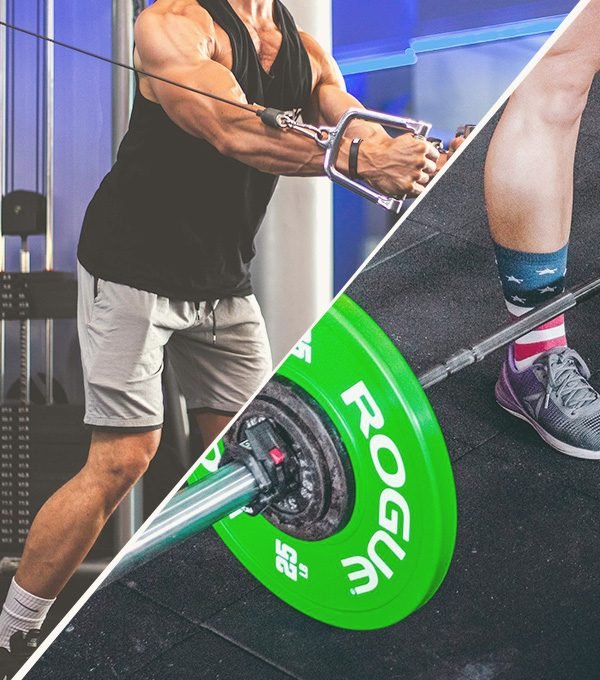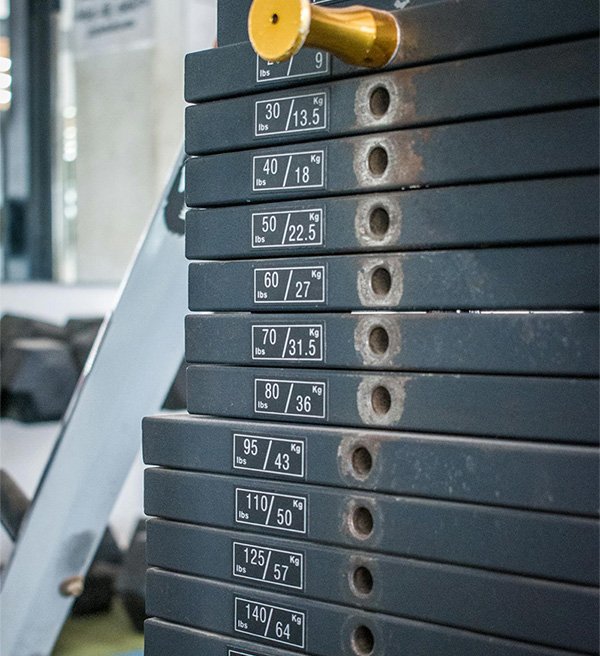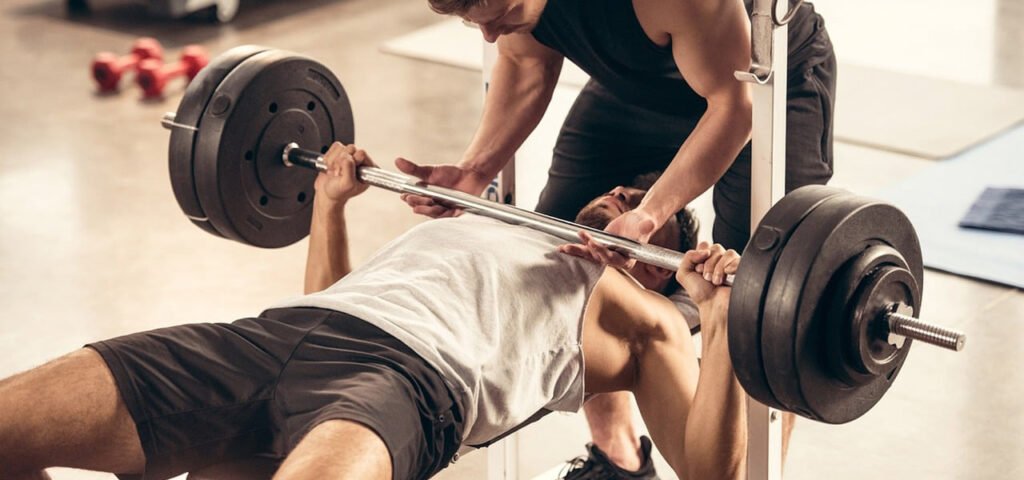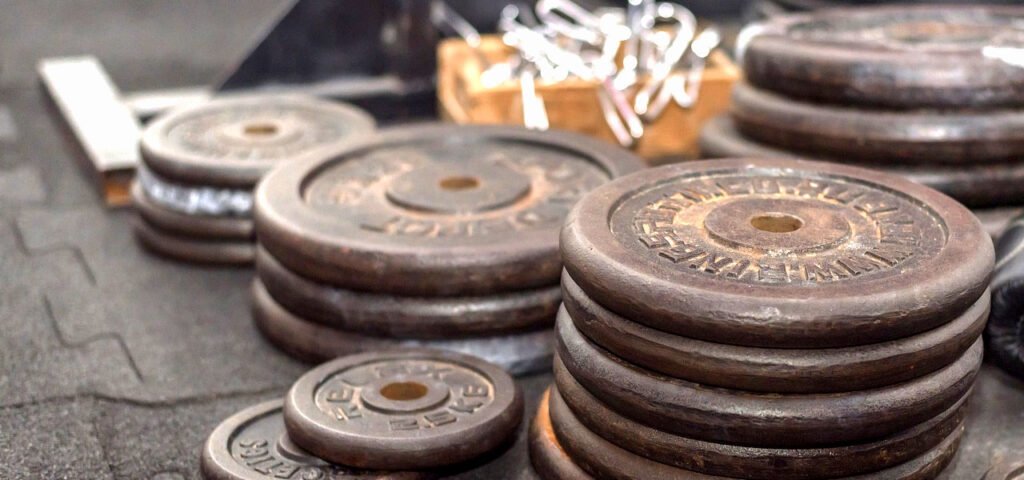
What are the potential challenges in developing a strength training program? The most important choice you will make is the type of equipment you will use for your training. Free weights and cable machines are two common kinds of equipment with different purposes and benefits. If you are setting up a home gym, a cable machine will be particularly useful because it is versatile and allows you to target a specific muscle region of the body precisely and securely. Free weights have the greatest benefit. They require the stabilizing muscles to be engaged and functionally strong because they allow you to perform strength training that mimics real life and is not confined to three dimensions like a machine.
Cable Machine vs. Free Weights: A Comprehensive Comparison for Strength Training Success
Table of Contents
ToggleNew Posts
When picking equipment and understanding their best use, you can build a great program that uses both to help achieve fitness goals. This will depend heavily on what kind of equipment you are using for your isolation or compound exercises.
This guide will compare and contrast cable machines and free weights fully, including customization, safety, muscle engagement, cost, and effectiveness. Let’s begin!
What Are Cable Machines and Free Weights?
Two essential pieces of equipment for strength training are cable machines and free weights; each has a distinct function and training approach. To choose the one that best suits your unique exercise objectives, skill level, and available workspace, it is essential to understand the differences between them.
Cable Machines: Versatility and Consistency
Cable machines, also known as pulley machines, are outfitted with cables that offer resistance for training, weights or plates, and adjustable pulleys. These machines are a great option for strength training because they are designed to support a variety of tasks. Whether targeted or all-encompassing, home gym cable machines provide a safe setting for targeting particular muscles or adhering to a program.
Key Features:
- Adjustable Pulley System: Enables a full range of exercises and angles.
- Constant Resistance: Creates an essential tension during each movement of the body.
- Safety: Especially for beginners or anyone with joint issues, the guided pathway reduces the risk of injury.
- Multi-functionality: Having a single piece of equipment that can work every region of your body reduces the amount of room needed in a home gym.
Examples of Cable Machine Exercises:
- Tricep pushdowns to isolate the triceps.
- Lat pulldowns for upper back and biceps.
- Cable chest flies for pectoral activation.
- Cable crunches for core strength.
Free Weights: Freedom and Functionality
Kettlebells, barbells, and dumbbells along with other free weights provide an unparalleled abundance of natural movements. This kind of multi-joint workout that improves synchronization across numerous muscle groups, calls for a sturdy core. Cable machines cannot match the variety of motion patterns that free weights offer, which supports the development of higher muscle mass and athleticism.
Key Features:
- Motion That has no Limits: You can move your body in any natural way without any restriction.
- Stabilizer Muscle Engagement: Latent muscles are activating, fostering balance and coordination.
- Multipurpose: Can do unilateral and multi-joint activities.
- Portability: Easy to use and can be moved around to different places, the ideal equipment for home gyms.
Examples of Free Weight Exercises:
- Barbell squats for full-body engagement.
- Dumbbell bench press for chest and triceps.
- Deadlifts to strengthen the posterior chain.
- Kettlebell swings for explosive power and endurance.
These distinctions provide the basis for selecting suitable equipment that matches your requirements, be it the accuracy and security provided by cable machines or the freedom of use offered by free weights. Each of them has a function that fulfills an overall strength-building regimen.
Muscle Engagement: How Each Equipment Type Works
Cable Machines: Targeted Muscle Activation
Cable machines are great for targeting a specific muscle from a specific angle. In contrast to free weights, which offer varying tension over the entire range of motion, cable machines maintain their resistance throughout. A perfect muscle engagement occurs during a bicep curling as the movement starts as well as ends at the same angle as the machine. They are therefore particularly useful in the case of pushing down the triceps and lateral lifting when tension has to be maintained. Additionally, cable machines are highly customizable, allowing you to adjust pulley positions, resistance levels, and grips to target muscles from various angles. This versatility makes them suitable for anyone healing from injuries or those focused on muscular imbalances.
Key advantages of cable machines for muscle engagement:
- Constant tension ensures muscles remain engaged at all times, eliminating rest points within the movement.
- Controlled movement paths reduce reliance on momentum, emphasizing the targeted muscle group.
- Adjustable angles and attachments provide diverse training possibilities, enabling targeted muscle activation for virtually any body part.
- Beneficial for rehabilitation exercises and injury prevention due to their joint-friendly mechanics.
Example: Tricep Pushdowns
Using a cable machine to perform tricep pushdowns gives you a steady, fluid motion that keeps your triceps engaged. You can target different areas of the tricep muscle group by altering the angle of resistance by varying the pulley’s height. Additionally, the cable’s continuous tension optimizes muscle activation at the peak and bottom of the exercise.
Free Weights: Comprehensive Muscle Engagement
Because there are no restrictions on movement, free weights are the most effective at exercising every muscle group in a single action. The body must balance and steady the load when using free weights, requiring the use of both smaller stabilizer muscles and prime move muscles. Because of their effectiveness, they may be used to do compound exercises that increase functional strength and work out a wider range of muscles, like squats, deadlifts, and bench presses. In the same way, free weights provide a natural movement pattern, reducing the likelihood of imbalances brought on by the guided pathways of fixed equipment.
Key advantages of free weights for muscle engagement:
- Full-body activation: Compound lifts involve multiple joints and muscle groups, promoting overall strength and coordination.
- Functional strength: Free weights mimic real-life movements, improving performance in daily activities and sports.
- Stabilization benefits: Engaging core and stabilizer muscles enhance balance, coordination, and injury prevention.
- Flexibility in load placement: Free weights can be held in different positions, allowing for creative and varied training approaches.
Example: Barbell Squats
Barbell squats are a key free-weight exercise that mainly targets the quads, hamstrings, and glutes, while also involving the core, lower back, and stabilizing muscles. This exercise is appropriate for lifters of all skill levels since variations like front squats and overhead squats can shift the focus on other muscle groups, such as the shoulders or core. Because there’s no fixed path, lifters need to focus on maintaining proper form and control, which improves neuromuscular coordination and strength.
Effectiveness of Strength Training
Cable Machines and Progressive Overload
The foundation of strength training is progressive overload, requiring steady increases in resistance over time. Beginners and intermediate lifters can obtain progressive overload with the help of cable machines, which provide a regulated and adaptable environment. Consistent development is ensured by the guided path and changeable settings, making modifying your resistance easier.
Key benefits of cable machines for progressive overload:
- Smaller weight increments on the stack allow for gradual increases without overloading the muscles too quickly.
- Built-in safety mechanism features lower the risk of injury, allowing lifters to push closer to their limits without needing a spotter.
- Targeting particular muscle groups and angles guarantees balanced development throughout your body.

Those who are interested in building muscle find cable machines especially useful. They keep the muscle tense throughout its entire range of action, essential for muscle growth. Cable machines also perform exceptionally well in sophisticated drop sets and pre-exhaustion methods. For example, doing cable flies before a bench press maximizes the activation of the chest muscles during the subsequent complex activity by helping to exhaust them.
Best Practices:
- Utilize cable machines for accessory exercises such as face pulls, lateral raises, and tricep pushdowns to enhance muscle definition.
- Gradually increase resistance or training volume to ensure continuous progress.
- Implement advanced techniques like supersets, drop sets, or pyramid sets to elevate your workouts.
Free Weights and Progressive Overload
For lifters who want to build as much muscle and strength as possible, free weights are frequently the best option. The weights can be gradually increased to meet your strength improvements, giving you a limitless chance for progressive overload. Additionally, free weights work stabilizing muscles, fostering functional strength that applies to everyday tasks.
Advantages of free weights for progressive overload:
- Significant strength improvements can be achieved over time with the ability to add larger weights.
- Functional movement patterns mimic everyday activities and improve overall athletic performance.
- Experienced lifters can further push their muscles with free weights by using techniques like isometric holds, eccentric overload, and tempo adjustments.
Exercises like squats and barbell deadlifts, for example, are essential lifts in strength training. In addition to using a variety of muscle groups, these complex movements allow significant weight increases. Additionally, lifters can increase smaller, easier-to-manage weights with the use of accessories like microplates, which ensures consistent growth while lowering the risk of injury.
Best Practices:
- To increase general strength, give priority to foundational movements like bench presses, deadlifts, and squats.
- To progressively increase weights, especially for smaller muscular areas like the shoulders and biceps, use microplates.
- To keep your muscles active, experiment with varied lifting tempos, foot positions, and grip variations.
You may create a comprehensive strength training program that covers every aspect of muscle building and functional fitness by combining the special benefits of both cable machines and free weights.
Safety and Convenience
Why Safety Matters in Strength Training
Safety is, without question, one of the most important aspects of strength training, of all, and for all who are strength training at home and the gym. The risk of suboptimal construction, muscle tightness, or injury may halt the process and lead to irreversible physical disability. Using equipment designed with safety in mind not only minimizes these risks but also helps maintain consistency in your workouts—a key component of achieving results over time.
Cable Machines: Safer and Beginner-Friendly
Cable machines are also well known to have safety equipment and as such make a good choice for beginners and convalescent. With the guidance provided by the guided pathway of pulleys, it is possible to train with the correct biomechanics, that is, with a lower incidence of strains or inappropriate motor patterns. Furthermore, since the load is attached to a stack but not free from it, very heavy loads could not fall.
Key benefits for safety: Key benefits for safety:
- Controlled Movements: Cable machine-guided swole allows the user to perform exercises with correct postures even when the user is untrained.
- Joint-Friendly: Cable machines facilitate arc movements, and thus lower forces on the articulations and tendons, and are therefore suitable to a greater extent for an elderly population or individuals with joint conditions.
- No Spotter Needed: Unlike free weights, cable machines don’t require a spotter, which lets you exercise more independently and with greater confidence.
- Customizable Settings: Angle and resistive adaptation create a personalized experience that keeps the working muscles tough while preventing activity in weak areas.

Free Weights: Experience and Care Required
Free weights, highly versatile, however, should receive greater consideration in terms of safety due to the absence of restraint. Free weight exercise is ideal when performed correctly, as incorrect technique can lead to serious injuries. Heavy lifts, for example, squats or bench presses, can always necessitate a spotter to maintain safety in case of a lift failure.
Tips for safer free weight training:
- Start Light: Initially, use lower weights in the movement to practice good execution before using higher weights.
- Use a Power Rack: For exercises like squats or bench presses, a power rack with safety bars will stop the weight being lifted if the lift should be interrupted mid-movement.
- Warm-Up and Stretch: Complete preparation minimizes the chance of muscle or joint damage.
- Progress Gradually: Steer clear of “ego lifting” by focusing on steady and controllable weight gains.
The Importance of Safety for Long-Term Success
For safe advancement, employees must be properly equipped with safe training approaches so that they do not cause problems in the future (i.e. accidents). Whatever home gym cable exercise machine or free weights is used, the best thing to do is to do as much as possible to stay safe so that it becomes possible to train regularly and achieve fitness goals without having to reschedule a workout because of an injury. Of course, the ideal workout program is the one you can sustain over the long term, and that starts with mitigating risks in the training routine.
Cost and Accessibility: Making the Right Choice for Your Home Gym
Home Gym Cable Machines: A Versatile Investment
Owning a home gym cable machine is a whole new adventure, particularly for the individual who desires an extremely powerful workout space. Despite the initial cost looking high, benefits are clear in terms of money, saving time, etc. With a cable machine, you’re essentially combining the functionality of multiple pieces of equipment into one compact and durable setup. These types of machines allow you to execute hundreds of exercise motions ranging from tricep pushdowns up to cable crossovers and to work for all main muscle groups. A space-saving system for home gyms, whatever their size, does not involve the buying and storing of single-unit machines or weights.
Key Reasons to Choose a Cable Machine:
- Long-Term Value: With evenly dispersed in the 3000 price spectrum, the lifetime and multi-usage of cable machines make them a good buy. They do not require attachments to maintain and are thus more cost-effective in the long term.
- Space Efficiency: Compact models have been engineered specifically to be compact and squeeze into tight areas so they are well suited for apartments or space-constrained home gyms.
- Tailored Workouts: Flexible pulleys and a variety of attachments provide for endless customization, which in turn, allows one to target specific muscle groups and modify exercises according to his/her fitness level.
- All-in-One Solution: Cable machines are suitable for everyone, from beginners to very experienced weightlifters, and, in particular, for use in a family gym with a large user base.
Free Weights: Affordable and Space-Efficient
Free weights remain the backbone of strength training for a good reason—they are versatile, strong, and cheap. All for the low price of $100, one can get started with a starter set of dumbbells and then add more as the strength improves. Free weights also can lend themselves to mobility, allowing potential users to carry them out of or into a site or the outdoors in a workout. Experienced lifters may choose to augment their setup with a squat rack, bench, or specialty bars, but even so, the total price is reasonable.
Why Free Weights Are a Great Option:
- Cost-Effective: Start small and build your collection over time. Adjustable dumbbells or barbell sets guarantee the principle of overload by progressive overload without requiring additional purchases.
- Versatile Training: Compound lifts, such as squats and deadlifts, and isolation lifts such as bicep curls, and free weights are for anyone.
- Compact and Portable: In comparison to a bigger machine, free weights can be stored in a closet, under a bed, or neatly stored up against a far corner and thus are a good fit for a small environment.
- Customizable Add-Ons: Your goals change, you can add cheap accessories such as resistance bands, kettlebells, or weighted vests) to your setup).
Which Option Offers More Bang for Your Buck?
The answer to this lies in your own fitness goals and room restrictions. A cable machine in the home gym is a good option if one looks for convenience, safety, and multi-functionality. It provides a controlled and efficient workout experience, ideal for targeting specific muscles and achieving progressive overload without additional purchases. In contrast, free weights are the best option for physique users who also need strength function, portability, and cost. They are also a better option if you prefer a more hands-on, personalized training style.
Simply considering your needs, budget, and space limits will allow you to make a smart choice that transforms your home gym into a place for working out progress.
Workout Variety and Customization
Cable Machines: Endless Variations
Cable machines, above all, are excellent at providing a large amount of exercise options and are the foundation of almost every strength training program. Due to their flexible pulleys and range of attachments, a wide variety of novel movements can be made that potentially stimulate muscles at every angle. The degree of this customization permits the personalization of exercise with the portion of exercise specifications that user wishes to target, i.e., isolating a single muscle or the multi-directional movements of a functional exercise. Moreover, cable machines are very efficient in context of unilateral exercises, which are valuable for normalizing muscle imbalances and enhancing coordination.
Examples of Versatile Cable Machine Exercises:
- Face Pulls: Train the upper back and rear deltoid muscles and posture.
- Cable Lateral Raises: Isolate the deltoid muscles for shoulder definition.
- Woodchoppers: Target the obliques and core for rotational strength.
- Cable Squats: Combine lower body engagement with core stability.
- Cable Chest Flyes: Focus on pectoral muscle development with constant tension.
- Overhead Tricep Extensions: Work the triceps at an unusual angle that’s hard to do with free weights.
- Standing Cable Rows: Hip extensors, gluteal, adductors, lats, traps and rhomboids are the muscles activated to improve posture and to generate pulling strength.
Given all of these possibilities, cable machines ensure your workouts are dynamic and anticipatory. Fine-tuning and angles enable fatigue-to-fatigue exercise, and continuous overload, which avoid plateau.
Free Weights: Infinite Freedom
Free weights offer unmatched versatility and freedom of movement. In contrast to machines, as they do not restrict your freedom to move, they permit natural, functional exercises that imitate natural movement in daily life. This versatility gives the free weights a very specific kind of force application in isotonic and compound exercises as well as sport-specific conditioning exercises. Control over your exercises, through the option of varying grips, stance, and equipment combinations, provides total freedom to pursue your workout that matches both your needs and personal preferences.
Examples of Versatile Free Weight Exercises:
- Turkish Get-Ups: A full-body exercise that improves strength, stability, and mobility.
- Dumbbell Snatches: Improve athletic performance and develop explosive power.
- Weighted Carries: Practice exercises like farmer’s carries to strengthen your grip, core, and shoulder stability.
- Landmine Presses: More precisely, focus on the shoulder and core while delivering a joint-friendly press maneuver.
- Barbell Lunges: Engage quadriceps, glutes, hamstrings and enhance balance and coordination.
- Goblet Squats: An easy-to-learn squat modification that promotes proper technique and focuses on the core.
- Renegade Rows: Row and plank exercise for core and upper extremity muscle forces.
The variety of free weights options for an uncountable number of choices and potential exercise program options makes your workout program pretty unlimited. Whether you’re focusing on hypertrophy, strength, or endurance, free weights adapt to your evolving fitness needs, making them an indispensable part of any workout plan.

Which Is Better for Your Home Gym?
The decision between a cable machine and free weights for a home gym depends on fitness goals, preference, and layout of the activity space. We’re going to demystify it so you can approach the decision with confidence.
Choose a Cable Machine, If the Top Priorities Are Flexibility and Ease of Use
A cable machine for a home gym is a perfect one-stop solution for the user’s needs with maximum flexibility. It provides prescribed movements with which to minimize the risk of injury, which are appropriate for novices and those recovering from injuries. On a cable machine, you can do a good variety of exercises—isolation such as tricep pushdowns versus kinetic such as woodchoppers—all in one and on the same small space set up. Furthermore, the possibility of parameter customization, allows you to focus on each muscle group by carefully adjusting the angles and the resistance individually.
Why it’s a great choice:
- Safe and user-friendly for solo workouts.
- Minimal joint strain, ideal for injury prevention.
- Compact design fits well in smaller spaces.
- Highly adaptable for a wide variety of exercises.
Free weights are worth considering when you are training for functional strength and freedom.
Free weights are the equipment of preference for individuals who wish to acquire raw strength, power, and balance. Their ability to make naturalistic movement imitations is of significant practical importance when seeking to improve athletic movement performance and functional fitness. Whether it’s mastering squats, deadlifts, or the Turkish get-up, free weights train your body to provide stability and coordination in different ways. They are also a budget option that enables you to start small with a curated collection and then expand it over time.
Why it’s a great choice:
- Encourages natural, unrestricted movement.
- Builds core strength and stabilizer muscles.
- Cost-effective and portable.
- Perfect for compound lifts and full-body workouts.
Why Not Both? The Best of Both Worlds
Can’t decide? You don’t have to! A considerable number of training enthusiasts agree that using a cable machine in connection with free weights provides the best home gym setting. The cable machine is worn for isolation training and employing steady tension and free weights are used for compound exercises and functional training. With this approach, one can get variability, avoid workout plateaus, and ultimately ensure a homogenous fitness program.
Pro Tip: In so far as time and money allow it, the purchase of both types of equipment is likely to guarantee the longevity of a home gym that is responsive to your changing fitness needs and goals. Imagine it is a lifetime investment for the health and functioning of yourself.
So, which will it be? A portable home gym cable machine, unrestricted use of free weight work, or a combo of both? It’s your call, and either way, it’s already scrubbed from the list of things in your “workout” and cut short of your fitness schedule. Start building your dream home gym today!
Final Thoughts: Combining Cable Machines and Free Weights
What’s the point of having just one if all you can get is the best of all of them? In a strength training program containing cable machines and free weights training, the value of a very significant change and effectiveness comes about. Cable machines are very interesting as they allow to isolate muscles in a radically specific way thanks to the associated guided movement with a high potential for causing injury, while also ensuring a steady tension. Nonetheless, FWT’s natural, functional, resistance training, postural control training, and coordination training can be implemented that cannot be implemented using the FWTs in isolation.
Exercising with these two types of machines guarantees balance and diversity in the training exercise. Cable machines can be applied to achieve muscle singulation, to enhance technique, or to volume increase safely in high repetitions strength training. Suggesting prioritizing free weights for the main core lifts of squats and deadlifts, which can activate multiplanar muscles and develop task-specific strength. These are combined to form a master training module for novices and experts of the lifts.
Investing in both also future-proofs your fitness journey. On the other hand, as the objective changes, the usability of a cable machine, the inherent ability to get better from free weight training, etc., will push you to get better.
So what are you waiting for? Begin your home gym today with a reliable home gym cable machine and a highly functional home gym free weight set. Together these are all going to make it possible for you to get to where you want to be in fitness quicker, simpler, and in a more inclusive way than ever before. Your endeavor to physique and recovery is just a click away!
New Posts
Related Posts
KEEP IN TOUCH.
SUBSCRIBE TO GET
THE LATEST
NEWS & UPDATES
















